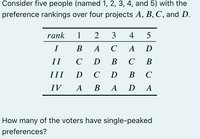
ENGR.ECONOMIC ANALYSIS
14th Edition
ISBN: 9780190931919
Author: NEWNAN
Publisher: Oxford University Press
expand_more
expand_more
format_list_bulleted
Question

Transcribed Image Text:Consider five people (named 1, 2, 3, 4, and 5) with the
preference rankings over four projects A, B, C, and D.
rank
2
3
4
I
В
A
C
A
II
с D B св
III
D C
D B C
IV
A B
A D A
How many of the voters have single-peaked
preferences?
Expert Solution
This question has been solved!
Explore an expertly crafted, step-by-step solution for a thorough understanding of key concepts.
Step by stepSolved in 2 steps

Knowledge Booster
Learn more about
Need a deep-dive on the concept behind this application? Look no further. Learn more about this topic, economics and related others by exploring similar questions and additional content below.Similar questions
- Question 2 is only for background informaitonarrow_forwardFrom a certain place K, 2000 people set off for work in the distant place S in the morning by car. Each of the drivers must decide whether to come to place S via point G or via point D (see the directed graph below). The travel time on segments G-S and K-D is not dependent on the number of drivers: each driver traverses the G-S segment in 60 minutes, and the K-D segment in 45 minutes, regardless of the number of drivers. However, the travel time on segments K-G and D-S depends on the number of drivers: if x drivers travel on the K-G segment, each driver on this segment consumes 0.005x minutes; if x drivers travel on the D-S segment, each driver on this segment consumes 0.01x minutes (see the directed graph below). Assume that all people start simultaneously and do not know the decisions of other people. Find all pure Nash equilibria of the game.arrow_forwardasumming Two firms produce a homogeneous good and compete in prices. Consumers buy the good from the firm that charges the lower price. In case the price charged by the two firms is the same, the firms split the demand. The linear demand curve for the product is given by Q=100A−P. Bothfirmshavethe same constant marginal cost of 40. (a) [10] Plot the best response functions on the axes, recording p1 on the horizontal axis and p2 on the vertical axis. Label the two best response functions. Make sure that you explain what the prices in equilibrium (and profits) for the two firms are when they choose prices simultaneously and interact only once. Assume now that both firms choose simultaneously but interact an infinite number of times. Each firm discounts the future based on the discount factor 0 < δ < 1. (b) Show under which range of δ collusion is an equilibrium in this market. Explain the various steps. (c) Repeat the analysis in (b), but assuming now that the two firms compete in…arrow_forward
- You are partners with Alice and Mark. You contributed 50% of the capital, Alice contributed 30%, and Mark contributed 20%. (a) How would the annual profits of $100,000 be distributed among all three of you? (b) Using these same numbers, how would an annual loss of $80,000 be distributed between the three of you?arrow_forwardWhat P(s1) would the decision-maker be indifferent between the "buy" and "make" decisions, all other data input remaining the same?arrow_forwardGiven attribute cutoffs of Price = 5, Quality = 5, and Weight = 4, which of the following would be chosen using the disjunctive decision rule? Price Quality Ease of Use Multiple Choice HP HP 5 3 3 Dell Dell Samsung 4 4 3 3 Samsung 5 ны Samsung and Dell would be considered further. 1 Samsung and HP would be considered further.arrow_forward
- If the FC = $200, the VC of the 9th unit is $400, and the VC of the 8th unit is $300, then ___: a) The MC curve is above the ATC curve at the 10th unit;b) The MC of the 8th unit is $80;c) The ATC of the 8th unit is $80;d) The AVC of the 8th unit is $75.arrow_forwardI need the answer as soon as possiblearrow_forwardOnly typed Answerarrow_forward
arrow_back_ios
arrow_forward_ios
Recommended textbooks for you

 Principles of Economics (12th Edition)EconomicsISBN:9780134078779Author:Karl E. Case, Ray C. Fair, Sharon E. OsterPublisher:PEARSON
Principles of Economics (12th Edition)EconomicsISBN:9780134078779Author:Karl E. Case, Ray C. Fair, Sharon E. OsterPublisher:PEARSON Engineering Economy (17th Edition)EconomicsISBN:9780134870069Author:William G. Sullivan, Elin M. Wicks, C. Patrick KoellingPublisher:PEARSON
Engineering Economy (17th Edition)EconomicsISBN:9780134870069Author:William G. Sullivan, Elin M. Wicks, C. Patrick KoellingPublisher:PEARSON Principles of Economics (MindTap Course List)EconomicsISBN:9781305585126Author:N. Gregory MankiwPublisher:Cengage Learning
Principles of Economics (MindTap Course List)EconomicsISBN:9781305585126Author:N. Gregory MankiwPublisher:Cengage Learning Managerial Economics: A Problem Solving ApproachEconomicsISBN:9781337106665Author:Luke M. Froeb, Brian T. McCann, Michael R. Ward, Mike ShorPublisher:Cengage Learning
Managerial Economics: A Problem Solving ApproachEconomicsISBN:9781337106665Author:Luke M. Froeb, Brian T. McCann, Michael R. Ward, Mike ShorPublisher:Cengage Learning Managerial Economics & Business Strategy (Mcgraw-...EconomicsISBN:9781259290619Author:Michael Baye, Jeff PrincePublisher:McGraw-Hill Education
Managerial Economics & Business Strategy (Mcgraw-...EconomicsISBN:9781259290619Author:Michael Baye, Jeff PrincePublisher:McGraw-Hill Education


Principles of Economics (12th Edition)
Economics
ISBN:9780134078779
Author:Karl E. Case, Ray C. Fair, Sharon E. Oster
Publisher:PEARSON

Engineering Economy (17th Edition)
Economics
ISBN:9780134870069
Author:William G. Sullivan, Elin M. Wicks, C. Patrick Koelling
Publisher:PEARSON

Principles of Economics (MindTap Course List)
Economics
ISBN:9781305585126
Author:N. Gregory Mankiw
Publisher:Cengage Learning

Managerial Economics: A Problem Solving Approach
Economics
ISBN:9781337106665
Author:Luke M. Froeb, Brian T. McCann, Michael R. Ward, Mike Shor
Publisher:Cengage Learning

Managerial Economics & Business Strategy (Mcgraw-...
Economics
ISBN:9781259290619
Author:Michael Baye, Jeff Prince
Publisher:McGraw-Hill Education